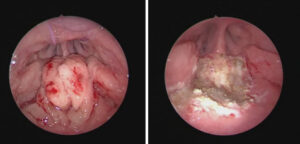Sinus Surgery

What is Chronic Sinusitis?
Chronic sinusitis is a persisting inflammatory condition of one or more sinuses. It is less common than acute sinusitis but appears to be getting more common in all age groups. Various treatments may be tried. Surgery to improve the drainage of the sinus is an option if other treatments fail, and usually works well.
What are the sinuses?
The sinuses are small, air-filled spaces inside the cheekbones and forehead. They make some mucus which drains into the nose through small channels.
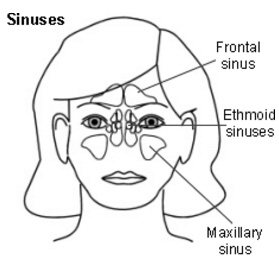
What is sinusitis?
Sinusitis means inflammation of a sinus. Most bouts of sinusitis are caused by an infection. The cheekbone (maxillary) sinuses are the most commonly affected.
Acute sinusitis means that the infection develops quickly (over a few days) and lasts a short time. Many cases of acute sinusitis last a week or so but it is not unusual for it to last 2-3 weeks (that is, longer than most colds). Sometimes it lasts longer. Sinusitis is said to be acute if it lasts from 4-30 days and subacute if it lasts from 4-12 weeks. A mild bout of acute sinusitis is common and many people will have some degree of sinusitis with a cold. Severe acute sinusitis is uncommon. Most people only ever have one or two bouts of acute sinusitis in their life. However, some people have repeated (recurring) bouts of acute sinusitis.
Chronic sinusitis means that a sinusitis becomes persistent and lasts for longer than 12 weeks. Chronic sinusitis is uncommon.
How do you get chronic sinusitis?
Most cases of chronic sinusitis develop following an acute sinusitis infection. Most cases of acute sinusitis go away within 2-3 weeks, often much sooner. In some cases the symptoms do not go and become persistent (chronic). The following are causes of acute sinusitis that may progress into a chronic sinusitis:
Cold or flu-like illnesses
In most cases, acute sinusitis develops from a cold or flu-like illness. Colds and flu are caused by germs called viruses which may spread to the sinuses. The infection may remain viral before clearing, causing a viral sinus infection. In a small number of cases, germs called bacteria add on to an infection that started with a virus. This can cause a bacterial sinus infection which can make the infection worse, last longer and may cause more damage or changes to the lining of the sinus.
Dental infections
In some cases, infection spreads to a cheekbone (maxillary) sinus from an infected tooth.
Other risk factors for sinus infection
In few people, one or more factors are present that may cause their sinuses to be more prone to infection. Acute sinusitis may be more likely to progress into chronic sinusitis as there is an underlying problem. Such factors include:
- Nasal allergy (allergic rhinitis). The allergy may cause swelling of the tissues on the inside lining of the nose and block the sinus drainage channels. This makes the sinuses more susceptible to infection. See separate leaflets called Hay Fever and Persistent Rhinitis which discuss allergic rhinitis in more detail.
- Other causes of a blockage to the sinus drainage channels, such as:
– Growths (nasal polyps).
– Objects pushed into the nose (especially in children, such as peas or plastic beads).
– Facial injury or surgery.
– Certain congenital abnormalities. (‘Congenital’ means you are born with these abnormalities.) - Asthma.
- Cystic fibrosis.
- A poor immune system – for example, people with HIV, people on chemotherapy, etc. A poor immune system makes you more prone to any infection. Fungal infections are rare causes of sinusitis and occur most commonly in people with a poor immune system.
- Inflammatory disorders such as Wegener’s granulomatosis or sarcoidosis.
- Pregnancy, which makes you more prone to nasal inflammation (rhinitis).
- Primary ciliary dyskinesia/Kartagener’s syndrome.
- Rare tumours of the nose.
- Smoking.
- Diabetes.
- Sniffing substances that irritate the lining of the nose (for example, cocaine).
- Previous injury to the nose or cheeks.
If you develop chronic sinusitis after an acute sinus infection, you may continue to get symptoms even though the infection has gone. (This is why treating chronic sinusitis with a normal course of antibiotics does not often work.) After being initially triggered by an infection, the persisting symptoms may be due to a combination of factors. For example:
- Poor drainage of the affected sinus – the sinus drainage channel may become fully or partially blocked.
- A build-up of mucus in the sinus.
- Inflammatory changes to the lining of the sinus that result from infection.
- A flare-up of infection from time to time as a result of these changes.
Sometimes, a persisting allergy can cause inflammation in a sinus and swelling or blockage of the drainage channel.
What is Functional Endoscopic Sinus Surgery?
Functional Endoscopic sinus surgery (FESS) is the surgery performed in patients of chronic sinusitis who are not responding even after complete medical management. FESS is a camera assisted endoscopic surgery in which all the sinuses are cleared of disease and inflammatory tissue and there openings are made wide with the help of a special shaver system called as microdebrider.
Post operatively patient’s nose is packed with special packs for 2-3 days and after removal of packs the patient is started on topical saline and steroid sprays which do not have any systemic side effects.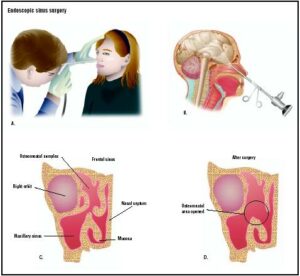
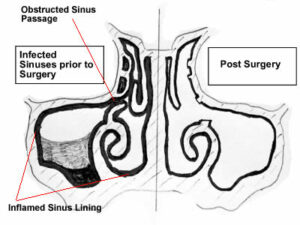
Tympanoplasty

Stapedotomy

Mastoidectomy

What are other Endoscopic surgeries performed?
Endoscopic septoplasty is done for deviated nasal septum which is causing significant nasal obstruction to the patient. It is done endoscopically under camera vision without any external scar to the patient. It is generally clubbed with bilateral inferior turbinate reduction which is also done endoscopically by using the microdebrider shaver system. It is a daycare procedure and patient is sent back home same day. The nose is packed with special packs for two to three days so that there is no bleeding.
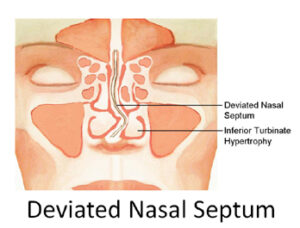
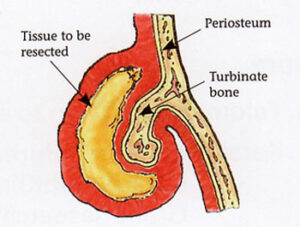
Endoscopic Dacrocystorhinostomy
Endoscopic DCR is the surgery performed for chronic dacrocystitis (watering from eyes because of blockage of the natural lacrimal or tear pathway) in which a new passage is created for the tears to drain into the nose endoscopically without giving an external scar to the patient.
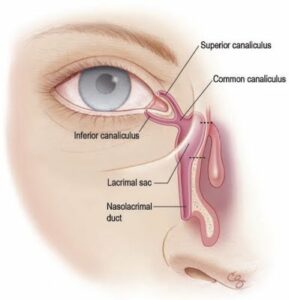
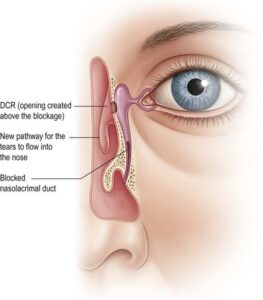
Endoscopic CSF Rhinorrhoea Repair
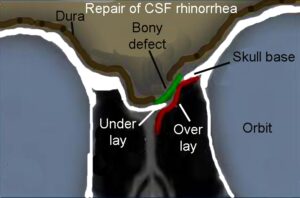
Endoscopic Coblation Adenoidectomy
Coblation Adenoidectomy is a bloodless removal of adenoid tissue from the nasopharynx (back of the nose) by using a special technology called as coblation which by means of generating a plasma of ions removes the adenoid tissue without any blood loss. It is completely safe in small children and the child can go back to school on next day of surgery. In this technology adenoids are removed under endoscopic vision so there is complete removal of tissue as compared to earlier performed curettage method of Adenoidectomy.
